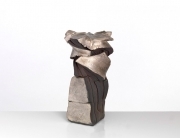Tamba in Hyogo Prefecture is perhaps one of the best-known modern cities where traditional yakimono arts continue to be a major way of life. This is perhaps ironic, however, as the town itself is still rather small. Back in 2004 the modern structure of Tamba was realigned.
Sannan, Kaibara, Kasuga, Hikami, Aogaki and Ichijima made up the old Hikami District. They were made into a single town that year, and even today there are less than 70,000 people or so that live there. Nevertheless, numerous classical shrines still stand like tall bulwarks against the relentless onslaught of history, and these provide a constant source of inspiration for the artists who live and work there.
Hachiman shrine is certainly the oldest, and probably the most famous for that matter. Nevertheless, there are numerous other historic Shinto sites for interested observers to inspect. As one of the six ancient pottery kilns of Japan, the town actually stretches way back into the late Heian and early Kamakura periods. This means that the area has sites and ceramic pieces that go all the way back to the 12th century.
What probably defines tambayaki more than anything else is the fact that the artists continued to look for pragmatic realistic solutions to everyday problems. Ceramic vessels made here over the years received designs based on the idea that they were to be actually used and not forgotten about or stored on shelves. As a result they have a very simple elegant appearance that tends to resemble artwork made in patterns based on Zen designs.
This design style is often referred to as shibui, and tends to have a typical dark brown glazing that runs toward a glossy black. Initially the local artists primarily made their wares to be sold only to local customers. They also primarily worked with ana gama hole kiln technology and many didn’t even use glaze. The pottery vitrified and turned into a sort of glassy material when the smoke and ash in the kiln reacted with it.
The Tamba Tachikui Kiln is a National Intangible Cultural Asset, and the area continues to fall under the protection of the Tamba Tachikui Pottery Cooperative Association. It may be fruitful to further investigate these groups before undergoing any serious study of this particular style, though the Yakimono Paris Gallery organization will continue to provide breaking information on goings on in the art form as they become available.



